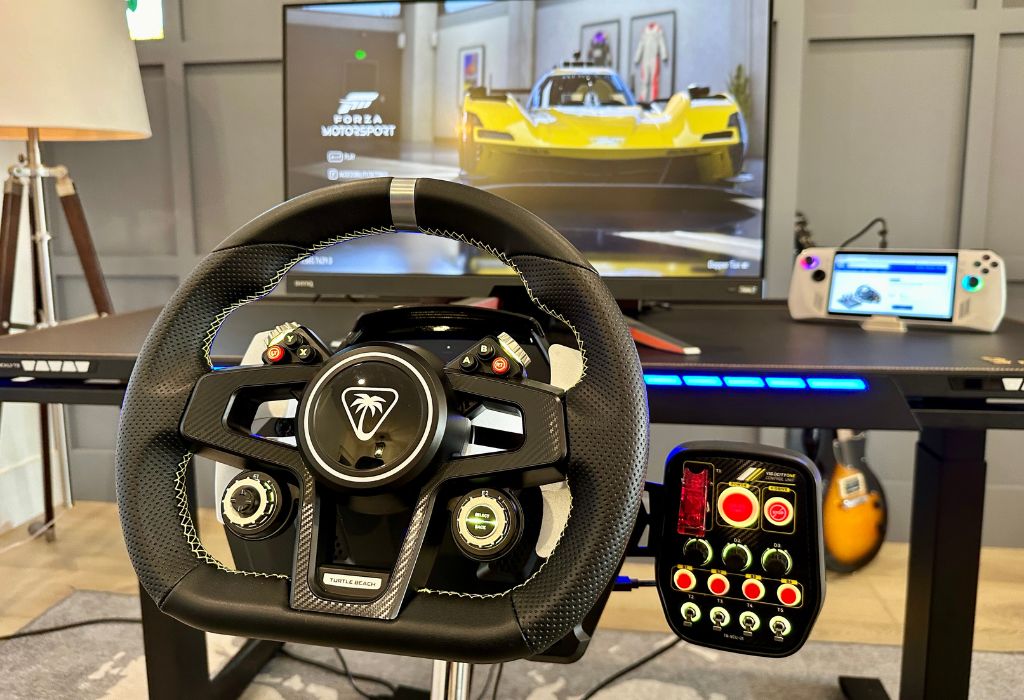
As a big racing sim fan, I was excited to test the Turtle Beach VelocityOne Racing Wheel & Pedal System. The package has the hardware to make any motorhead’s heart sing. Including a powerful, full-featured 7.2nm direct-drive wheelbase, button box, and load cell pedal set, the system aims to upgrade your racing experience. In this review, I’ll hit the track on both the Xbox and PC platforms to put the VelocityOne Race Wheel through its paces and see if it can earn its spot on the podium.
Unboxing the VelocityOne race wheel components
In my pursuit of building a great racing sim set-up, I’ve been able to test out quite a few racing wheels over the years. The VelocityOne has a few features, like the onboard display and overall customization, that make it stand out. The first thing I noticed while unboxing all the components is how well-organized everything is, with easy-to-follow instructions. The steering wheel itself is a leather-wrapped “D-shaped” wheel that feels great. The stitching on the leather looks sharp, adding a subtle but distinct aesthetic that complements the high-quality construction. It also features a comprehensive array of buttons and knobs, conveniently placed for easy access during races. All these buttons can also be re-mapped with on-board tools and the companion app. Overall, the sharp styling of the wheel looks like something plucked out of a real-life roadster.
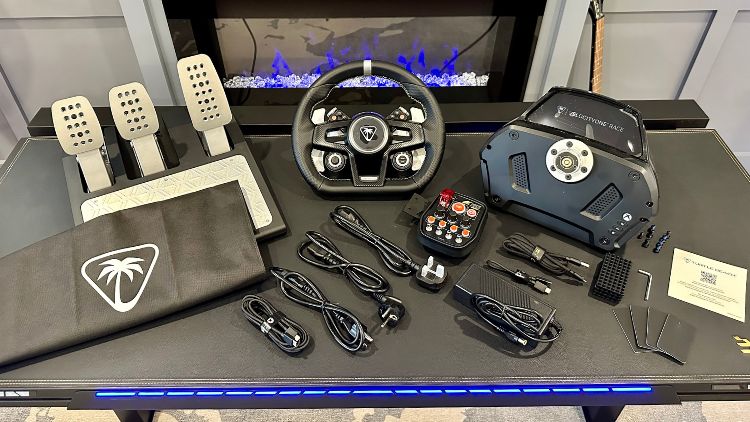
VelocityOne race wheelbase
The wheel is detachable and easily slotted into the next component I unboxed, the Race Wheelbase. The base features a lot of great extras that help to make set-up and racing a breeze. The unit features two side panels that flip open to expose a multi-tool that helps adjust the mounting clamps. I mounted the system to Turtle Beach’s VelocityOne Stand, which is sold separately. Alternatively, the unit can be mounted to a desk or tabletop ledge. For a more permanent solution, there are pre-drilled holes in the unit’s body to screw it into place. The wheelbase features two of the hardware’s best features: the Race Management Display and the 7.2Nm direct-drive force feedback motor. I’ll delve further into how both perform later in the review, but they add a lot to the overall racing immersion.

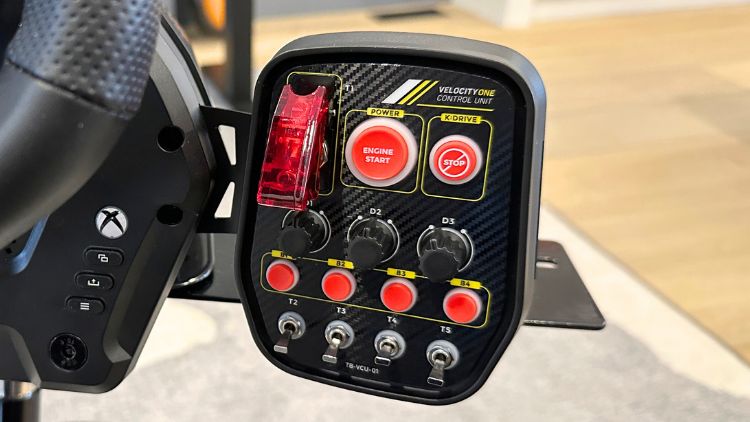
VelocityOne control unit
The base is accompanied by the “VelocityOne Control Unit” (VCU), a detachable switch/button-packed module. Here, you can map critical car systems and adjust the settings depending on the racing game you are playing. I must admit, it looks incredibly cool and the fact you press the “Engine Start” button to power the unit is a great touch.
Custom pedal system
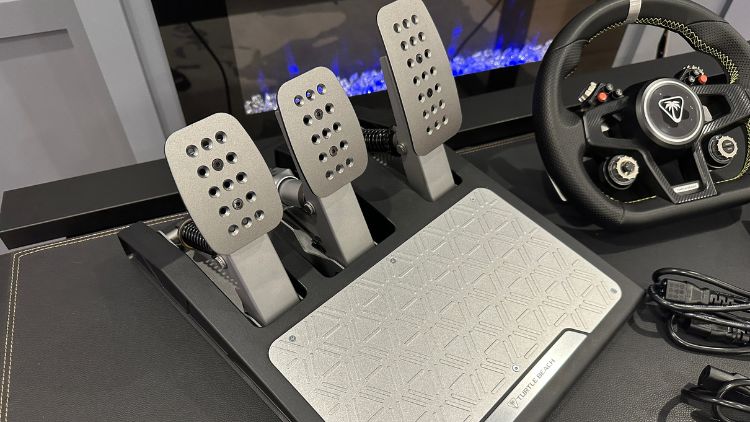
The last piece of the set-up is the pedal unit. The pedals’ build quality is impressive, they are constructed from aluminum and heavy plastics. They’re quite sturdy and feature a “dynamic Brake Tek load-cell braking system.” The technology offers resistance close to what you’d feel on the actual road. You can also customize the pedal height with the included multi-tool and stow the clutch when not in use. I really appreciate the amount of customization I can make to the pedal layout. Stowing the clutch or adjusting the pedal height makes it simple to find the “sweet spot.”
Setting up the VelocityOne race wheel system
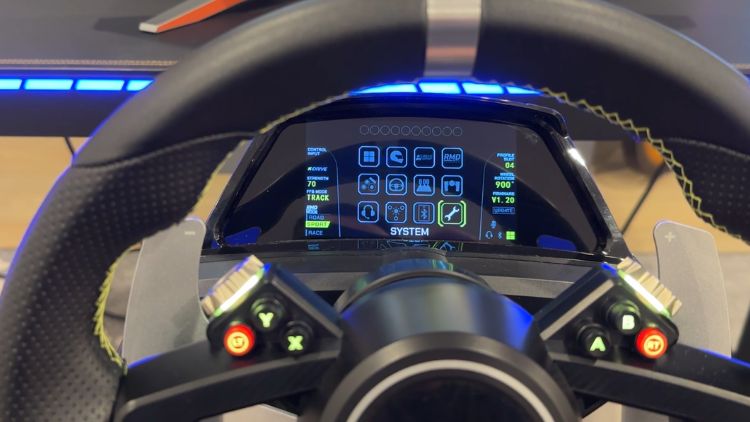
After unboxing all the different pieces of hardware, the setup is relatively straightforward. The included “Quick-Race Guide” does an excellent job of outlining all the steps needed to get you set up. When you first mount and configure the hardware, it will take time to assemble everything. Once you’ve completed the initial steps, the VelocityOne Race system is a joy to use. The Quick-Race Guide not only walks you through the physical assembly but also guides you through the software calibration process.
I did find using the wheel was practically “plug and play” on the Xbox platform. Playing games like Forza Horizon 5 and Forza Motorsport I was able to race right away. On the other hand, with the PC, there are mandatory updates required before hopping into the driver’s seat. As much as there are some extra steps for PC gamers, the process is still very streamlined all things considered.
VelocityOne Race hardware overview

Once everything was up and running, the first thing I noticed was the smoothness of the wheel’s motion. The force feedback from the wheelbase is incredibly realistic, simulating the nuances of a real car’s steering response. Whether you’re navigating tight corners or adjusting to changes in road surfaces, the feedback is immediate. I could tell the difference between surfaces and changes on the track which added to the immersion. The weather conditions in games like Forza Motorsport come through the wheel’s tactile feedback. Rain, in particular, is very realistic, and you can feel it when you start to hydroplane or lose control. The sensation of the tires losing grip on wet asphalt is conveyed with startling accuracy, making every decision to brake or accelerate a test of skill.
Fine-tuning like the pros
If you want to make adjustments to the system, the VelocityOne Tuner app software lets you customize it to suit your driving style. The app is available via PC and for mobile (iOS and Android) devices with Bluetooth. I made dozens of sensitivity adjustments to force feedback levels, as the app provides a comprehensive range of settings you can tweak. The user interface is intuitive, making it easy for both beginners and seasoned sim racers to find and adjust the options they need. Whether you’re practicing for a pro-event or just having fun, the VelocityOne setup delivers an immersive racing experience.
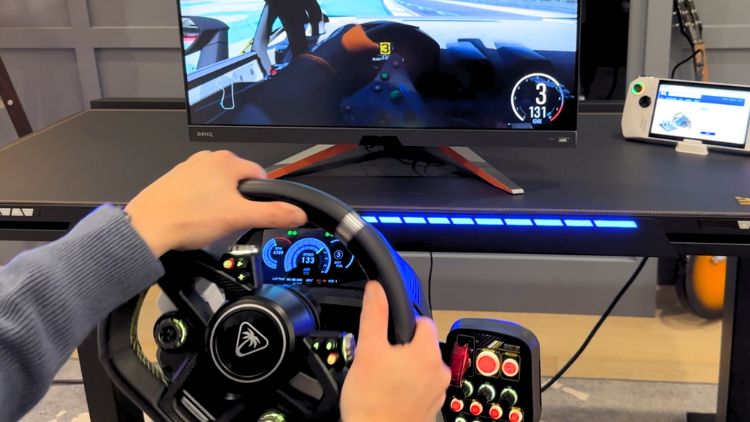
On-board Race Management Display
The Race Management Display (RMD) is a standout feature, offering real-time data to be shown that helps you make split-second decisions during a race. From lap times to tire pressure, this keeps you informed without taking your eyes off the track to look at other menus. In terms of aesthetics, it also looks great to have the display flickering with speed, RPM, and other racing telemetry.
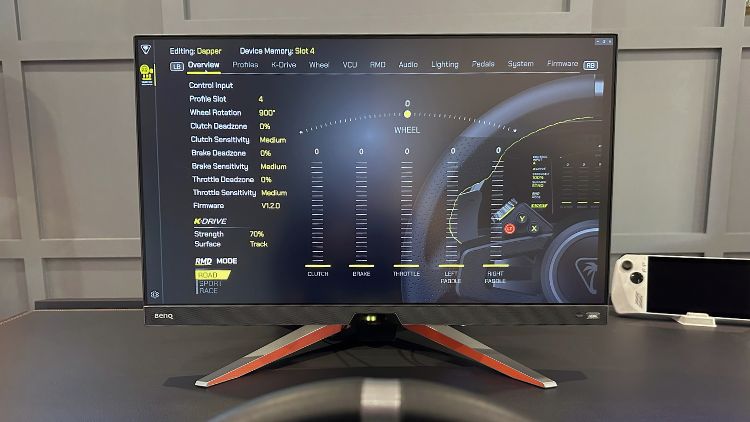
The one big downside of the VelocityOne on the Xbox platform is that the level of data displayed is very limited at this point. PC users currently have more options for far more robust data to be displayed via the RMD. You’ll still see some real-time telemetry data displayed while playing on the On Xbox Series X, Series S, or Xbox One but it’s nowhere near the rich data set that PC gamers currently enjoy. On the PC, there is a selection of titles that support the RMD live telemetry, which can be found here.
Pedal to the metal
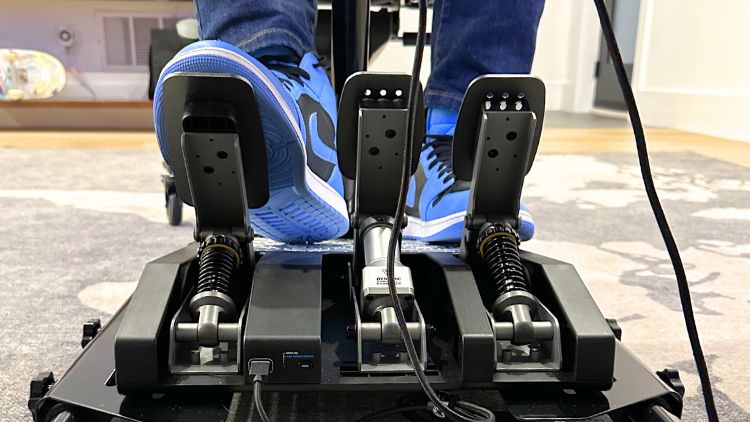
Overall, the Pedal Unit’s performance is impressive, with some design oversights that could use improvement. The Brake Tek load cell provides a level of resistance that mimics the feel of a real brake pedal. The ability to adjust the pedal height and stow away the clutch when not in use shows the thoughtfulness put into the design for both comfort and practicality. I did run into some issues with the placement of the USB-C connection cable at the back of the pedal unit, which caused the cable tip to bend. Due to its placement at the back of the unit, it was pushed against my entertainment unit and bent the cable. This could be remedied with a mount or a stand, but it would be ideal to have a connection spot where natural pedal inputs won’t comprise the connections. Outside of this issue, I found the pedal performance great.
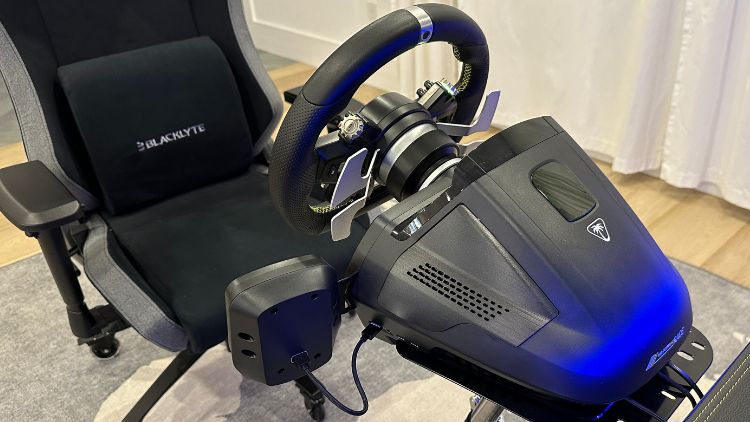
Final thoughts on the Turtle Beach VelocityOne Race
Overall, the Turtle Beach VelocityOne Race presents a great option for racing sim fans looking to level up their experience. With its direct-drive wheelbase, sophisticated button box, and robust load cell pedal set, it offers a set-up that both beginners and seasoned racers can appreciate. The wheel shines with its robust force feedback, detailed Race Management Display, and versatile customization options. While there are minor drawbacks, such as the limited telemetry data on the Xbox platform and the placement of the USB-C connection on the pedal unit, these are overshadowed by the system’s overall performance and quality. Overall, the Turtle Beach VelocityOne Race takes the checked flag in my books.




